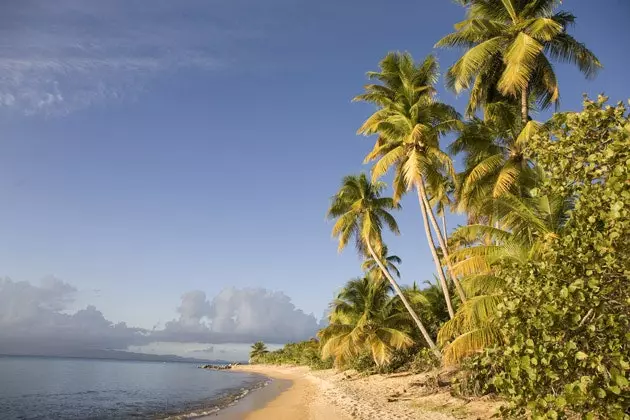
Green Beach, a good starting point for our beach route
The small propeller plane purrs and begins to descend. The nine passengers (and I imagine the pilot too) looked out the window: the view could not be more promising . On the turquoise blue sea, between waves of foam and white sand, the green silhouette is outlined dotted with palm trees, deserted beaches in the shape of a crescent and keys surrounded by coral. It is Vieques, Baby Island, an elongated sleeve 33 kilometers long by six wide that appears after a 20-minute flight departing from San Juan, Puerto Rico. Christopher Columbus stumbled upon this natural paradise on his second voyage to the New World. He must have found it just as intact as today. The Tainos, ancient pre-Columbian inhabitants, gave it a name: bieke, small island.
Until very recently the only 'tourists' were the Marines, who set up their firing range here in 1940 and controlled two-thirds of the island. A decade ago, when the US Army abandoned the base, the second Vieques discovery was made: spectacular flora and fauna, secluded beaches, sunsets never seen before, zero real estate pressure, mild weather from 20 to 32 degrees all year round and a bay – the famous bioluminescent bay – with microorganisms that give off light at night. The island is still quiet: the only noise that can be heard now is the coqui , a tiny native frog that emits a rhythmic and high-pitched sound, co-qui, co-qui... very relaxing. But let's go by parts.
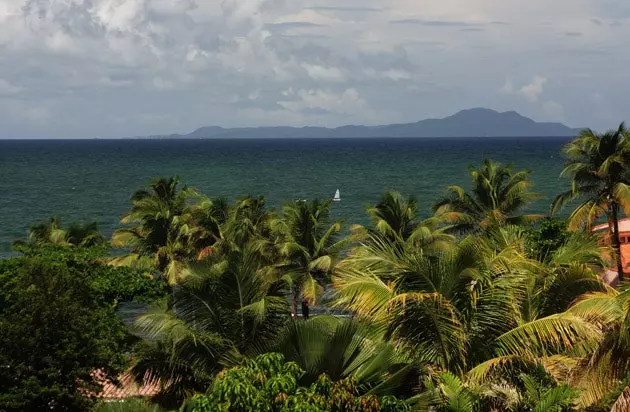
The flora and fauna of Vieques are spectacular
The plane lands at the tiny Antonio Rivera Rodríguez airport, north of Vieques. From the sky we have seen the complex of the W Vieques Retreat & Spa , our house on the island. Barely peeking out between the greenery and the coconut palms, there are 17 bungalows rhythmically lined up facing a swimming pool and two private coves . We arrive in ten minutes in a 4x4 and I am surprised by the excellent condition of the roads (no doubt a legacy of the American Navy), with hardly any traffic, except for a few stray cows, wild ponies and poultry. Sometimes a solitary iguana.
The W Vieques, with 156 rooms, now occupies the buildings of the old Martineau Bay Resort, the first large hotel that opened in 2003 when the territory was demilitarized. It has been renovated by Patricia Urquiola , the Spanish architect and designer who is successful all over the world. In the lobby, a large central house with the reception, the bar and the Sorcé restaurant, chairs made with strips of colored plastic, gigantic poufs and a 25 meter long metal panel with large digital flowers created by Studio Urquiola they immerse you in the bohemian and contemporary atmosphere of Vieques. The 'handmade' matters here : There are crochet lamps, curtains with thick ropes and shades of beige, strawberry and light blue that recall the Puerto Rican tradition.
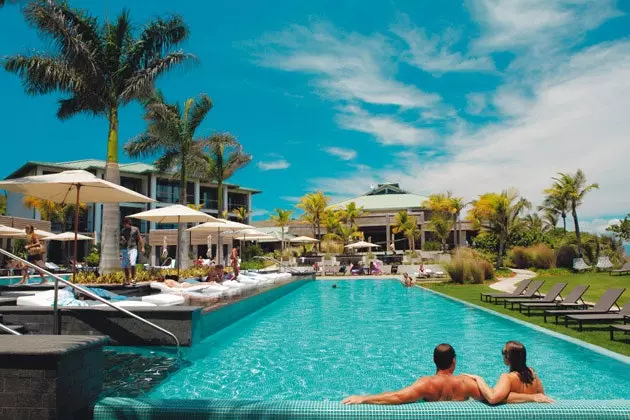
W Retreat and Spa Vieques
On the outside, the cement of the complex's architecture was attenuated to the maximum with metallic gratings where the native vegetation , and the open spaces on the terraces allow you to enjoy panoramic views of twelve hectares facing the sea without interruptions . It begins to get dark, and we head to the villa, on foot along a dirt path (for them: heels off) with very low lighting for protect turtles that nest in the sand , a few meters from the hotel. the room has the same balsamic island feel , a rustic elegance that fuses luxury with nature: an ideal vacation spot for a newlywed couple. This is how this piece of Caribbean land is, beautiful and wild.
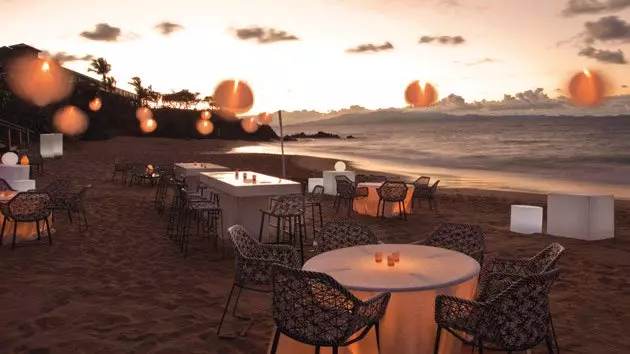
W Retreat is a hotel with a balsamic effect
ENDLESS PLAYING
Any Viequense who is asked about the most beautiful things on their island will quickly talk about their beaches . Personally, I agree: many and very beautiful. Some, like Sun Bay , next to the town of Esperanza, are extensive, crowned with palm trees and easy to get to. Others, less civilized and exquisitely remote, like Secret Beach, Half Moon or Ship . Finding them driving on highways and byways in a rental car is a delightful pastime. Many have incredible coves for snorkeling (you will definitely experience one of the best water rides in the Caribbean here), and in some it is possible to find little more than a dozen bathers on the same day.
It is impossible to choose. There are so many that every day you can meet a different one: let's start with the north coast. Green Beach It is a good starting point. On weekends it is full of boats arriving from Puerto Rico and St. John, a nearby island, whose occupants are mostly given over to goggles and tubes. a little higher, Punta Arenas It is the northwestern tip of the island, where the Caribbean and the Atlantic meet. The currents are so strong that bathing is prohibited , but it is worth the getaway to see the meeting of the sea and the ocean. Atlantic winds make Chata Beach , a little further east, the mecca of surfing. It is not good for swimming, but it is good for enjoying the views of a picturesque sunset of the sister islands Culebra and Culebrita (if you can't, climb the 300 meters of Monte Pirata, the highest peak on the island) .
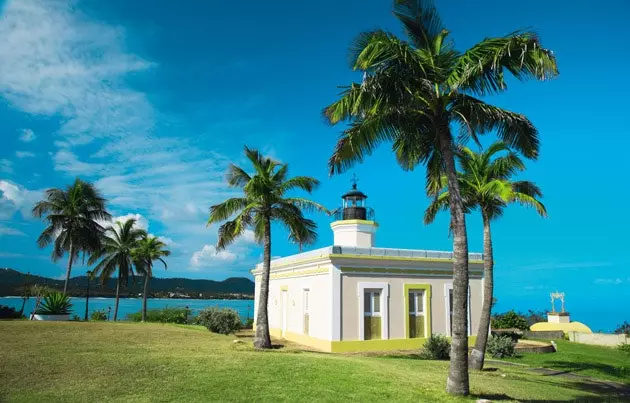
Castle of San Felipe del Morro with its lighthouse from 1843
In the south, a group of beaches vies for the title of Miss Tranquility. Garcia Beach (or Playuela) is the most secluded. It will be because you have to walk a kilometer and a half from the parking lot. A little later, Caracas Beach (or Red Beach, because they all have their names in English here) , with white sand and turquoise waters, is more popular, but getting up early grants you the privilege of occupying an open cabana to organize a picnic or sip a cold wine at sunset. Supplies can be purchased at So Food , a kiosk with pinchos, empanadas and sandwiches with the freshest ingredients. The smallest beach in the area, Tight Paw (Secret Beach), as its name suggests, guarantees solitude and snorkeling for the few spaces in its parking lot. But one of the most photogenic is Blue Beach (La Chiva), so long and so blue that it was easy to name her. A large sandbank allows you to enjoy shallow water to sit or lie in the sun in the water.
there are still Playa Escondida, La Plata or Playa Grande . If you can, visit them all. When you want to return to civilization, Sun Bay Beach it's your place: picnic tables, toilets, showers and beach bars await you near the town of Esperanza. only experts know Bold Beach , a small cove with black volcanic sand, only accessible after a short walk. The landscape in shades of green, blue and black, surrounded by cliffs, here is truly otherworldly.
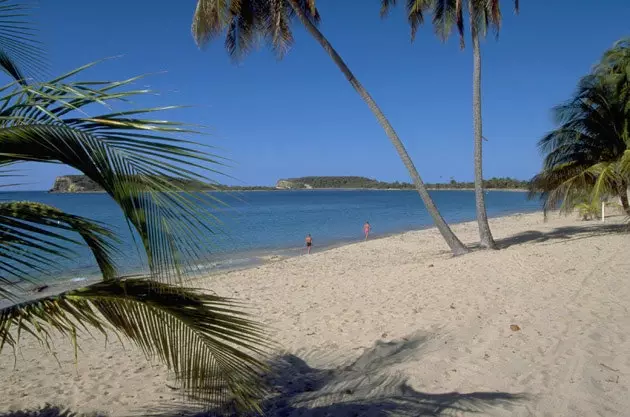
Sun Bay Beach, the most "civilized" beach in Vieques
THE CAPITAL: THE OBLIGATED URBAN WALK
During the day, Isabel II , the capital of the island, deserves a walk. Its houses with one or two floors are striking, with their ocher, fuchsia or aqua blue facades and their wrought iron lattices and lattices. Part of the charm of Vieques is its people, free and nonconformist . Artists, intellectuals and hippies from all over the world have lived here since the 70s. Expats and creative people who left New York and other cities for the palm trees and the Caribbean. Many have galleries in these streets, like Siddhia Hutchinson , which opened a room and studio in 1985 to exhibit Caribbean-themed acrylics, oils, and sculptures, its own and those of other local artists. She also teaches introductory classes in painting, with her advice to create powerful and colorful paintings.
Visit the Fort Count of Mirasol, from 1840, built on a hill. Was built by Raphael de Aristegui (whose county title gives it its name) to control enemy attacks by Englishmen and pirates. Today, fully restored, houses a museum with the history of the island and temporary exhibitions of contemporary artists. At sunset, locals enjoy the Malecon , the boardwalk of Esperanza. It is the best spot to have a cocktail surrounded by locals, especially on weekends. La Central, Duffy's, Bananas, Mucho Gusto... all of them are in front of the sea and any one is good to drink and eat something in an informal way.
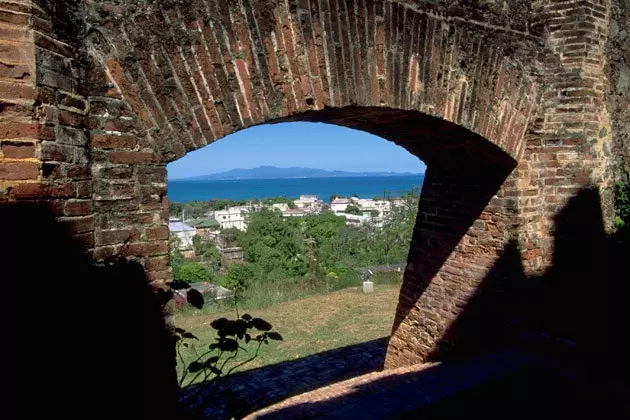
Isabel II seen from the Fortín Conde de Mirasol
When the power goes out in this fishing village it looks like the set of a tropical movie. The boats are moored and the restaurants are starting to come alive. In a charming colonial house is the Quenpo, romantic, collected and unpretentious. There is no air conditioning, but its windows are always open and the quality and creativity rule in its local fish and seafood dishes. Some tasty choices are the crab or lobster , and mofongo, a gooey but addictive Viequense dish with green plantain, garlic, and vegetables.
From the tables along the street you can see the bay, the vendors and some residents riding their horses. Don't expect to leave until dawn . Almost the entire island is in bed by midnight (luckily for the local flora and fauna). So the day is yours . No traffic lights, no McDonald's, no T-shirts with "I was in Vieques and I remembered you." And the best: no rain. Rest assured, the sun will always shine on this unadulterated, authentic piece of the Caribbean.
*This report has been published in the monograph number 72, Romantic Travel, by Condé Nast Traveler
